
 16
16




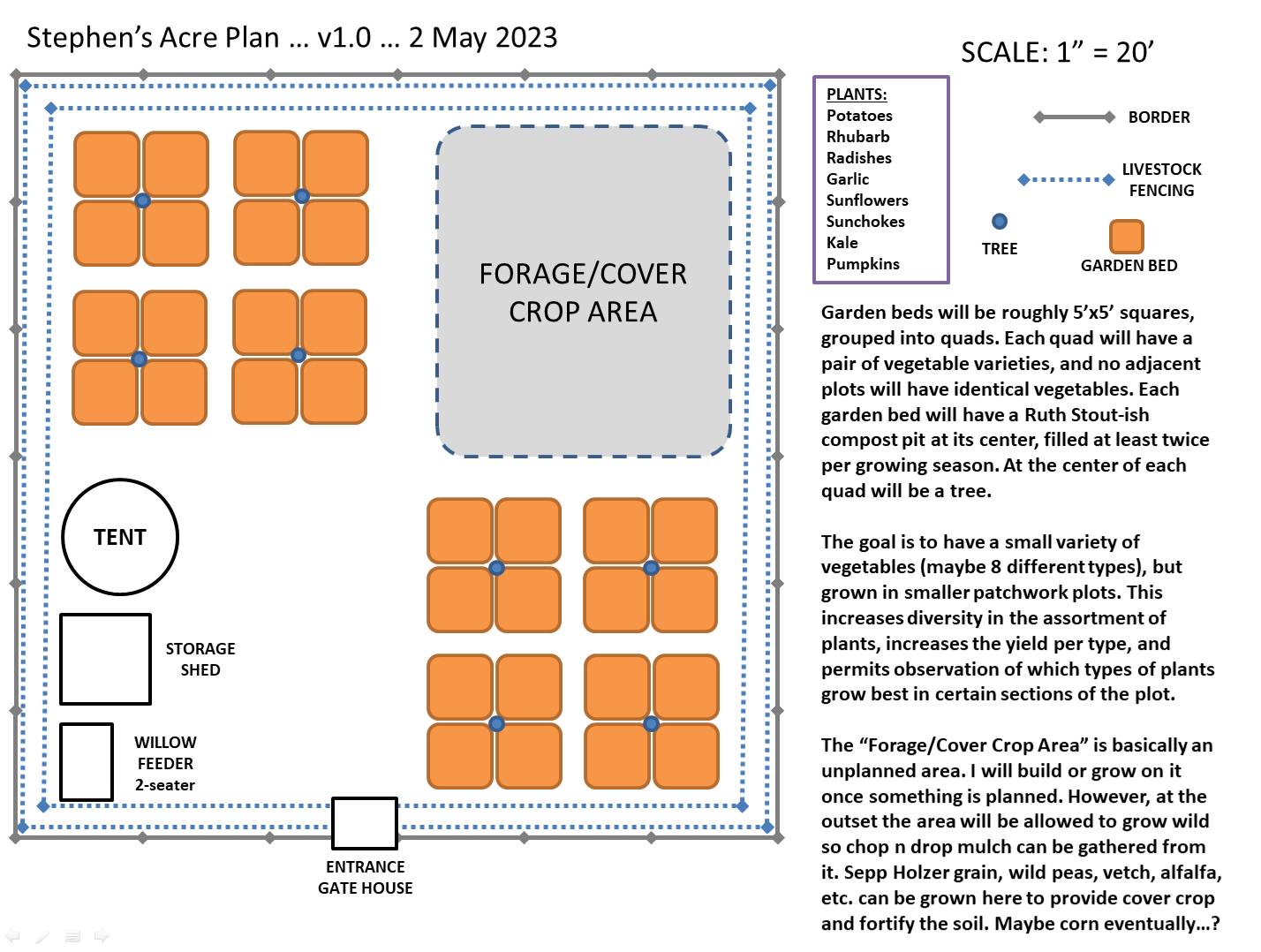

"We carry a new world here, in our hearts..." --Buenaventura Durruti
"Don't wish it were easier. Instead, wish you were better." --Jim Rohn
 5
5




The best gardening course: https://gardenmastercourse.com
Permies.com FAQ
 9
9




Liv Smith wrote:Stephen, welcome back! To posting (and I assume to Wheaton Labs).

"We carry a new world here, in our hearts..." --Buenaventura Durruti
"Don't wish it were easier. Instead, wish you were better." --Jim Rohn

 7
7




 9
9




 9
9




I make a Maple Syrup instructional movie! Check it out HERE
SKIP books, get 'em while they're hot!!! Skills to Inherit Property
See me in a movie building a massive wood staircase:Low Tech Lab Movie
 12
12




Christopher Weeks wrote:Actually, maybe your scale is the real issue. An acre is a ~208' square but your orange beds are supposed to be 5x5', so something is off.
Mike Haasl wrote:I agree that your scale must be off which gives a bunch of hope for how much you can grow there.

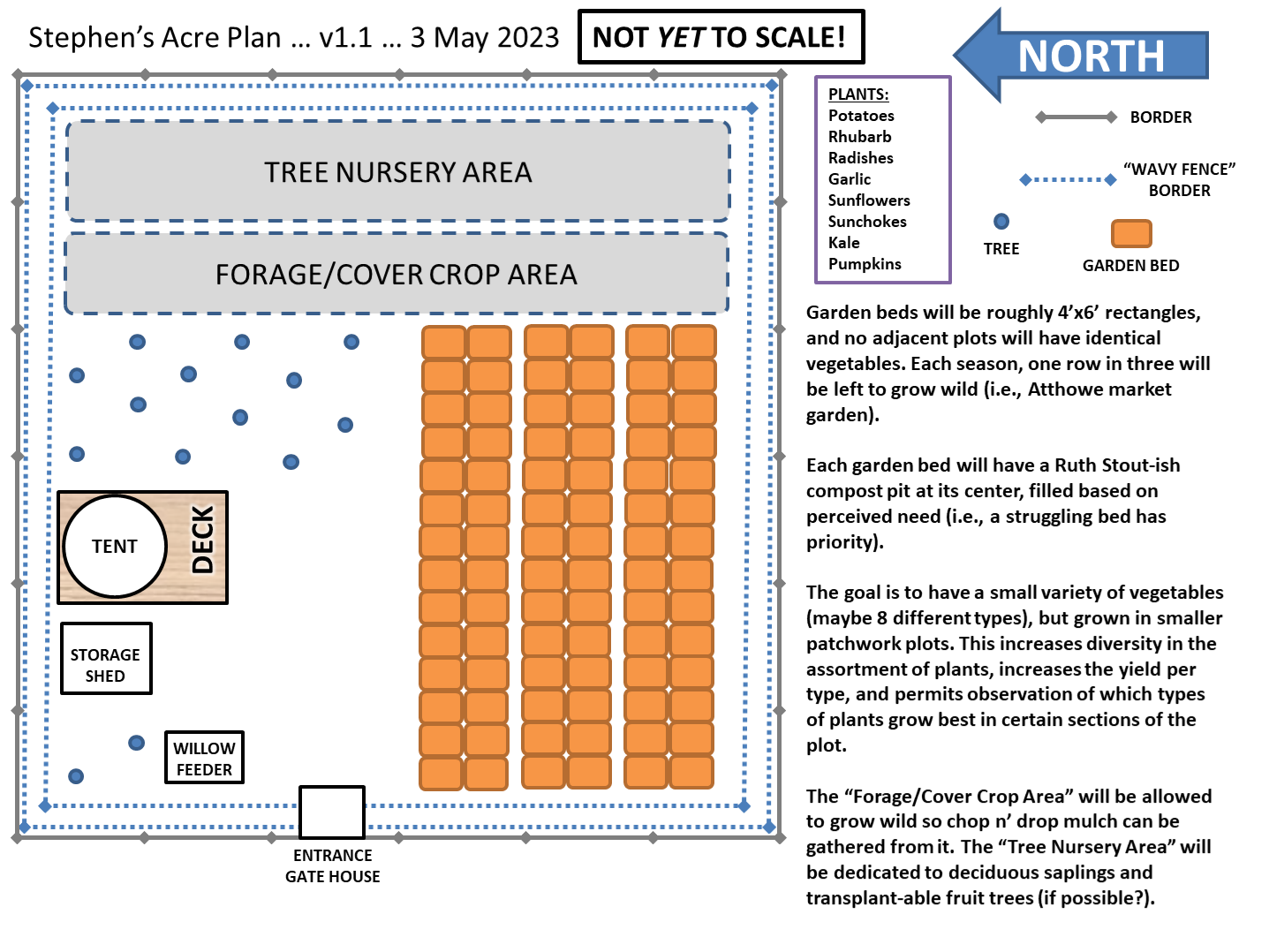

 9
9




I make a Maple Syrup instructional movie! Check it out HERE
SKIP books, get 'em while they're hot!!! Skills to Inherit Property
See me in a movie building a massive wood staircase:Low Tech Lab Movie
 12
12




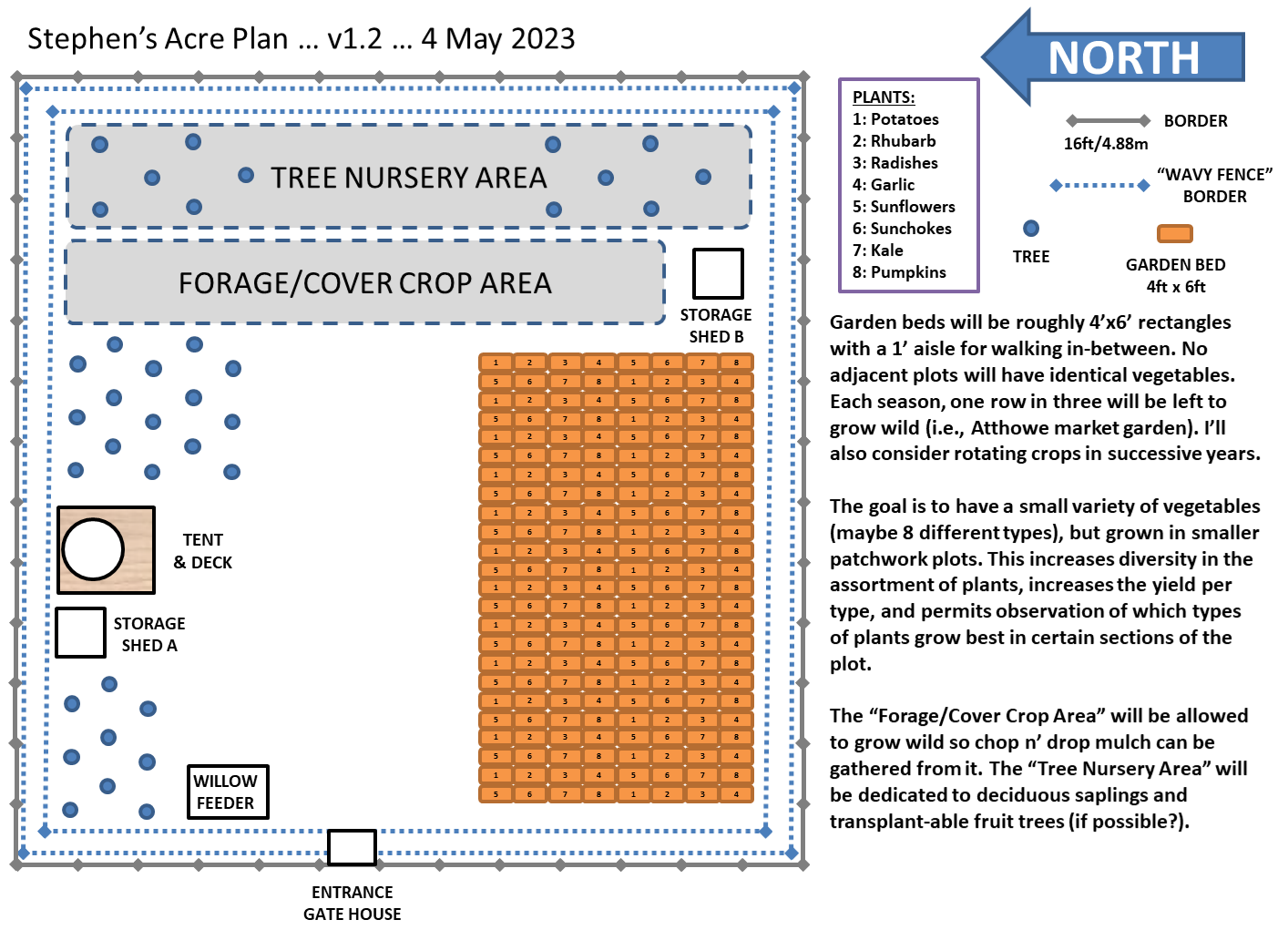
"We carry a new world here, in our hearts..." --Buenaventura Durruti
"Don't wish it were easier. Instead, wish you were better." --Jim Rohn
 14
14




I make a Maple Syrup instructional movie! Check it out HERE
SKIP books, get 'em while they're hot!!! Skills to Inherit Property
See me in a movie building a massive wood staircase:Low Tech Lab Movie
 9
9




Mike Haasl wrote:Garlic is planted in the late fall and harvested in July so it messes with crop rotations. I've had good luck planting it in a bed that is harvested when it frosts (potatoes or pumpkins would be an option). Once you harvest it the next year you can possibly get a short season crop out of that bed as well. Just need some planning.
"We carry a new world here, in our hearts..." --Buenaventura Durruti
"Don't wish it were easier. Instead, wish you were better." --Jim Rohn
 14
14




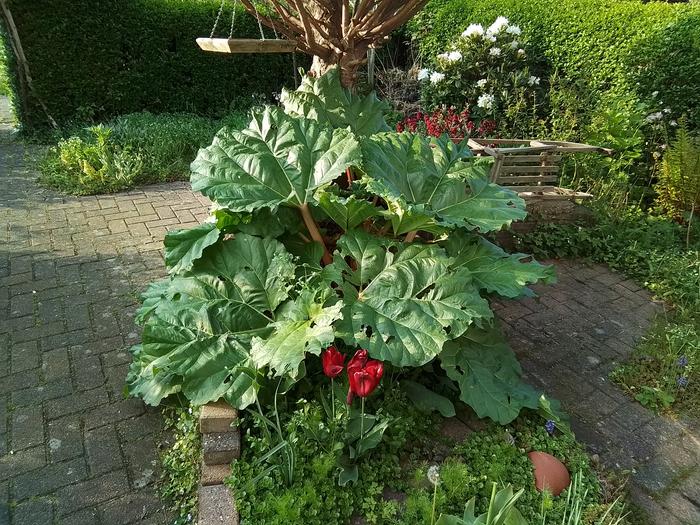
"Also, just as you want men to do to you, do the same way to them" (Luke 6:31)

 9
9




Hans Albert Quistorff, LMT projects on permies Hans Massage Qberry Farm magnet therapy gmail hquistorff
 1
1




 6
6




 6
6




www.simplesolarhomesteading.com
www.youtube.com/solarcabin
 4
4




Michael Kristoffersson wrote:Stephen, have you got a topographical map?
What data do you have regarding Sector Analysis?
To the north side (or the prevailing winter wind direction), what is the existing protection like?
"We carry a new world here, in our hearts..." --Buenaventura Durruti
"Don't wish it were easier. Instead, wish you were better." --Jim Rohn
 6
6




 7
7




LaMar Alexander wrote:Looks like a workable plan.
I am an old off gridder so I would probably include space for chickens for egg production and free fertilizer or possibly rabbits and a goat or 2.
My homestead is just about 3/4 of an acre and it is amazing what you can do with a small piece of land if you plan it out.
I am not real fond of tents but they can work for temporary living. If you plan to stay there permanently I would consider building a small cabin/
Best on your adventures!
"We carry a new world here, in our hearts..." --Buenaventura Durruti
"Don't wish it were easier. Instead, wish you were better." --Jim Rohn
 3
3




Stephen B. Thomas wrote:
Michael Kristoffersson wrote:Stephen, have you got a topographical map?
What data do you have regarding Sector Analysis?
To the north side (or the prevailing winter wind direction), what is the existing protection like?
Great questions. However, until I definitively choose a plot to inhabit, I won't have the answers. I've heard that the plots are marked-off somehow, but I've not taken a close-enough look to find out how and exactly where. One of these days...
I Eat My Yard.
You should eat yours too!
 4
4




There is madness to my method.
"Life finds a way"- Ian Malcolm
"We're all mad here" - The Cheshire Cat
 6
6




Cat Knight wrote:How about including an area for an outdoor kitchen or at least some food prep space?
"We carry a new world here, in our hearts..." --Buenaventura Durruti
"Don't wish it were easier. Instead, wish you were better." --Jim Rohn
 6
6







 6
6




Praying my way through the day
 3
3




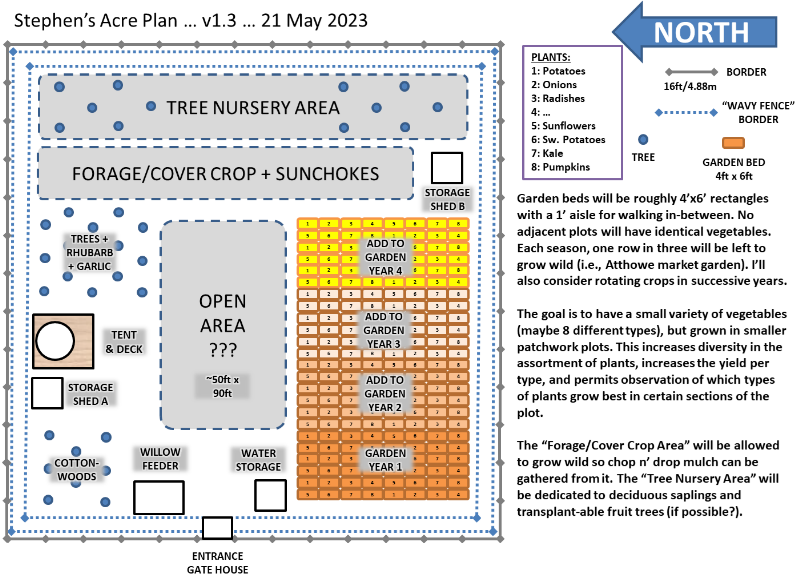

"We carry a new world here, in our hearts..." --Buenaventura Durruti
"Don't wish it were easier. Instead, wish you were better." --Jim Rohn
 5
5




I make a Maple Syrup instructional movie! Check it out HERE
SKIP books, get 'em while they're hot!!! Skills to Inherit Property
See me in a movie building a massive wood staircase:Low Tech Lab Movie






 3
3




"Also, just as you want men to do to you, do the same way to them" (Luke 6:31)
 8
8





"We carry a new world here, in our hearts..." --Buenaventura Durruti
"Don't wish it were easier. Instead, wish you were better." --Jim Rohn
 2
2




'What we do now echoes in eternity.' Marcus Aurelius
How Permies Works Dr. Redhawk's Epic Soil Series







 3
3




Joylynn Hardesty wrote:I see only one entance to your acre. Are you able to scale your proposed fence in case of emergency? Widfire in not common here. But it can happen.
Another fence is here, with a less-impressive gatehouse structure providing egress.
Hans Albert Quistorff, LMT projects on permies Hans Massage Qberry Farm magnet therapy gmail hquistorff
 4
4




Joylynn Hardesty wrote:I see only one entance to your acre. Are you able to scale your proposed fence in case of emergency?
"We carry a new world here, in our hearts..." --Buenaventura Durruti
"Don't wish it were easier. Instead, wish you were better." --Jim Rohn








 4
4




'What we do now echoes in eternity.' Marcus Aurelius
How Permies Works Dr. Redhawk's Epic Soil Series
 2
2




Joylynn Hardesty wrote:Something to keep in mind, what you can scale today, you may not be able to do iin five years. Shit happens. Ticks happen. But gates or doors can be added too.
Our acre is roughly 100X400 feet. Not conducive for a quick escape. Good thing for me it's not fenced! I'm well past my fence jumping years.
"The only thing...more expensive than education is ignorance."~Ben Franklin. "We can easily forgive a child who is afraid of the dark; the real tragedy of life is when men are afraid of the light." ~ Plato

|
Please all, and you will please none. - Aesop / tiny ad
Freaky Cheap Heat - 2 hour movie - HD streaming
https://permies.com/wiki/238453/Freaky-Cheap-Heat-hour-movie
|







